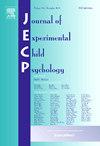Differential emotional responses to positive and negative visual perception in children and young adults: An electroencephalography study
IF 2
2区 心理学
Q3 PSYCHOLOGY, DEVELOPMENTAL
引用次数: 0
Abstract
Currently, the number of children with problems associated with mood disorders and emotion regulation is increasing. However, little is known about the development of emotional responses, especially in the developmental population.
To examine the temporal dynamics of emotional neuronal activation, we presented a subset of standardized emotional pictures from the International Affective Picture System dataset to 45 children and young adult participants. Of these, 15 were children (mean age = 10.0 years, range = 7.1–12.7; 6 boys) and 30 were young adults (mean age = 23.5 years, range = 18.9–33.1; 12 men). We used electroencephalography (EEG) to investigate the spatiotemporal dynamics of emotion processing and measured the brain responses elicited by positive and negative images. Differences in activation patterns were studied using topographic analysis of variance. The study was conducted at Miguel Hernández University in Elche, Spain. Our results show that brain responses move from a high amplitude signal in EEG responses to positive stimuli in children to a high amplitude response to negative stimuli in adults. We confirmed lateralization to the left hemisphere in the processing of positive emotions and to the right hemisphere for negative emotions in both children and young adults. We also found differences in the amplitude of the responses to emotional images between female and male participants, although these were significant only in adults (p < .05). Our results support and expand the existing knowledge about the differing processes of emotion processing in children and adults.
儿童和青少年对积极和消极视觉知觉的不同情绪反应:一项脑电图研究
目前,患有情绪障碍和情绪调节相关问题的儿童数量正在增加。然而,人们对情绪反应的发展知之甚少,尤其是在发育中的人群中。为了研究情绪神经元激活的时间动态,我们将来自国际情感图片系统数据集的标准化情绪图片子集呈现给45名儿童和青少年参与者。其中15例为儿童(平均年龄10.0岁,范围7.1-12.7;6例男孩),30例青壮年(平均年龄23.5岁,范围18.9-33.1;12人)。利用脑电图(EEG)研究了情绪加工的时空动态,并测量了正面和负面图像引发的大脑反应。利用地形方差分析研究了激活模式的差异。这项研究是在西班牙埃尔切的Miguel Hernández大学进行的。我们的研究结果表明,大脑反应从儿童对积极刺激的脑电图反应中的高振幅信号转变为成人对消极刺激的高振幅反应。我们证实,在儿童和年轻人中,处理积极情绪时左半球偏侧,处理消极情绪时右半球偏侧。我们还发现女性和男性参与者对情绪图像的反应幅度存在差异,尽管这些差异仅在成人中显着(p <;. 05)。我们的研究结果支持和扩展了现有的关于儿童和成人的不同情绪处理过程的知识。
本文章由计算机程序翻译,如有差异,请以英文原文为准。
求助全文
约1分钟内获得全文
求助全文
来源期刊

Journal of Experimental Child Psychology
Multiple-
CiteScore
4.50
自引率
7.70%
发文量
190
期刊介绍:
The Journal of Experimental Child Psychology is an excellent source of information concerning all aspects of the development of children. It includes empirical psychological research on cognitive, social/emotional, and physical development. In addition, the journal periodically publishes Special Topic issues.
 求助内容:
求助内容: 应助结果提醒方式:
应助结果提醒方式:


